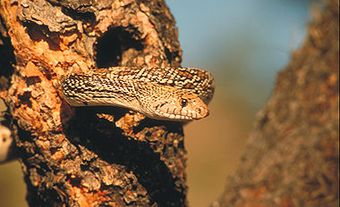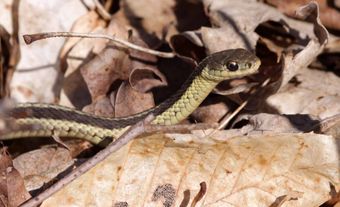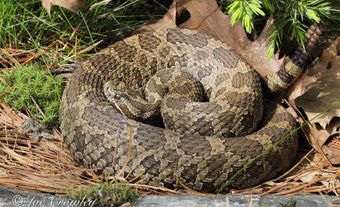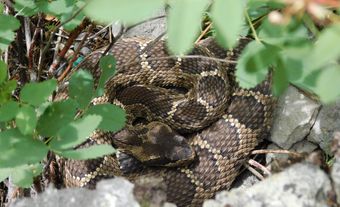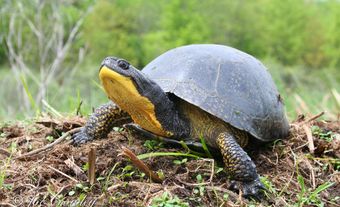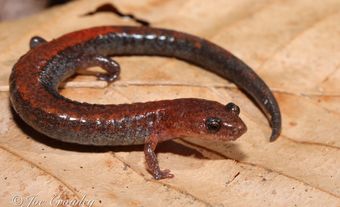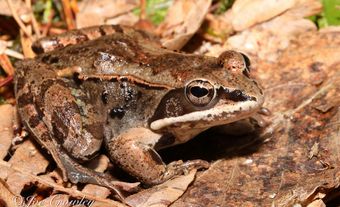The North American racer (Coluber constrictor) is a non-venomous snake that is native to North America. It has an extensive geographic range that extends from southern Canada south throughout most of the United States, parts of Mexico and into Guatemala and Belize. Eleven subspecies are recognized across this species’ range, three of which are found in Canada: the blue racer (Coluber constrictor foxii; ON), the Eastern yellow-bellied racer (Coluber constrictor flaviventris; SK, AB) and the Western yellow-bellied racer (Coluber constrictor Mormon; BC). (See also Snake Species in Canada.)

Description
The North American racer is a medium-sized snake that can grow to be just under 2 m long, although most individuals are much smaller than this. The scales are smooth and give individuals a shiny appearance. North American racers have an angular head that widens toward the back, a distinct neck, and large eyes with round pupils. Blue racers are blueish-grey, blueish-brown or blueish-green on the sides and back. They have a white chin and throat, and the underside is white, cream, blueish-white or blueish-grey. Individuals often have a black mask around the eyes that extends toward the back of the head. Both the Eastern and Western yellow-bellied racers have a yellow underside. The Eastern subspecies is uniformly blueish-grey, blueish-green, or brown on the back and sides while the Western subspecies is uniformly green, olive, yellowish-brown or reddish brown on the back and sides.
Hatchlings and juveniles of all three subspecies are heavily patterned and look very different from adults. They are light grey or light brown with a row of darker grey, brown, or reddish-brown blotches down the back with smaller spots on the sides and belly.
Did you know?
As the name implies, North American racers can move very fast. They rely on their speed and agility to escape predators. However, they are also excellent climbers and can rapidly ascend into trees and shrubs when fleeing danger. They also climb vegetation to bask in the sun, and it is not uncommon to find individuals draped over branches several metres above the ground.
Distribution and Habitat
The North American racer prefers warm temperatures and is poorly adapted to Canada’s cold climate. For this reason, its Canadian distribution is restricted to a few small, disjunct areas along the country’s southern border. In Canada, the blue racer is only found on Pelee Island, which supports a tiny population of a few hundred individuals. The Eastern yellow-bellied racer occupies three river valleys in extreme southern Saskatchewan and one river valley in extreme southeastern Alberta. The Western yellow-bellied racer is found throughout several of the mountain valleys in south-central British Columbia. The species is widespread south of the border, where it is found throughout most of the United States, parts of Mexico and in Guatemala and Belize.

North American racers generally inhabit dry, open to semi-open habitats that are sunny and warm. On Pelee Island, blue racers inhabit fields, savannah, alvar (limestone areas with little-to-no soil), thickets, hedgerows, forest edges and sparse woodland. In Canada, Eastern yellow-belied racers primarily inhabit riparian habitat (areas along the edges of waterbodies) and grasslands near river valleys. The Canadian populations of Western yellow-bellied racers are found in arid mountain valleys where individuals inhabit riparian areas, grassland and shrub steppe (shrub-dominated dry grasslands), sparse pine woodland, and rocky slopes. North American racers rely on large rocks, mammal burrows, woody debris, low-lying vegetation or other habitat features to provide shelter from predators and to avoid extreme temperatures. Females typically lay their eggs under wood, rocks or bark, in mammal burrows, in rotting logs or stumps, in compost or mulch piles, or under scrap wood, boards or other human-made debris.
North American racers hibernate underground in rock crevices, mammal burrows, or other features that allow them to get below the frost line. In Canada, Eastern yellow-bellied racers commonly hibernate in cavities and mammal burrows located in slumping bluffs of river valleys, while the Western subspecies commonly uses rock piles at the base of steep south-facing mountain slopes. North American racers have large home ranges, and individuals may travel several kilometres between their summer habitat and hibernation site. Suitable hibernation sites are often limited. Because of this, individuals often hibernate communally and in the company of other snake species, such as Western rattlesnakes or common gartersnakes. North American racers generally return to the same hibernation site each year.

Reproduction and Development
Female North American racers reproduce every one-to-two years. Mating primarily occurs in the spring (typically in May), shortly after emergence from hibernation. Females have been documented to produce an average of 13.6 eggs per clutch. However, the clutch size of the smaller subspecies, such as the Western yellow-bellied racer, tends to be smaller than this. Eggs are laid in June or July and hatch in the late summer. In Canada, females reach maturity at three-to-five years of age, and males slightly earlier. There is little information on the lifespan of the North American racer, but some individuals have been known to live for more than ten years in the wild.
Diet and Predation
North American racers are diurnal, meaning they are most active during the day. They are active foragers and hunt by smell and sight. North American racers eat a wide variety of prey, including small mammals, lizards, other snakes, birds, insects and spiders. Despite their scientific name, racers do not constrict their prey; instead, their meal is swallowed whole, often while it is still alive. Their main predators include birds, such as hawks and eagles, mammals (e.g., foxes, coyotes, skunks) and other snakes.

Threats
Snakes are frequently injured and killed on roads, particularly in areas with high road densities and traffic volumes. This can result in widespread population declines and is one of the greatest threats to this species in Canada. Habitat loss, such as from the conversion of natural areas to urban or agricultural land, is also a serious threat to this species in some parts of its range. Since racers often hibernate communally and depend on the same hibernation site over their lifetime, the destruction of these habitats can be especially detrimental.
Status and Conservation
Globally, the North American racer is listed as “least concern” by the International Union for Conservation of Nature. However, due to their limited distribution in Canada, as well as the severity of threats in many areas where populations occur, all three subspecies are listed as species at risk under the Canadian Species at Risk Act; the blue racer is listed as endangered, the Eastern yellow-bellied racer as threatened, and the Western yellow-bellied racer as a species of special concern. ( See also Endangered Animals in Canada.) However, in 2015, the Committee on the Status of Endangered Wildlife in Canada reassessed the Western yellow-bellied racer as threatened, and in turn its status under the Species at Risk Act may also be elevated.

 Share on Facebook
Share on Facebook Share on X
Share on X Share by Email
Share by Email Share on Google Classroom
Share on Google Classroom
